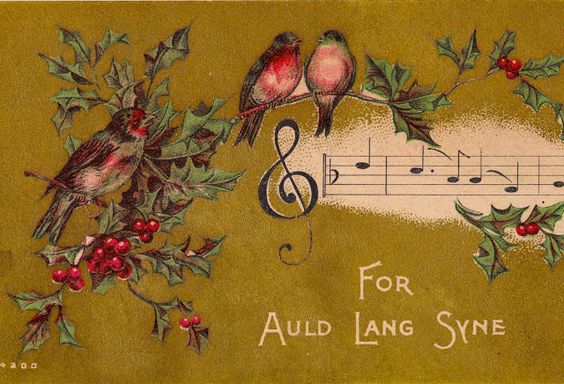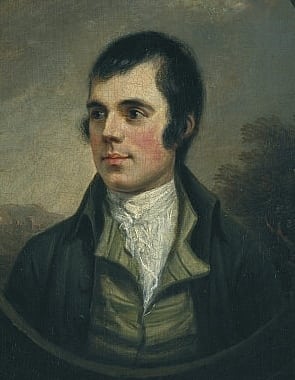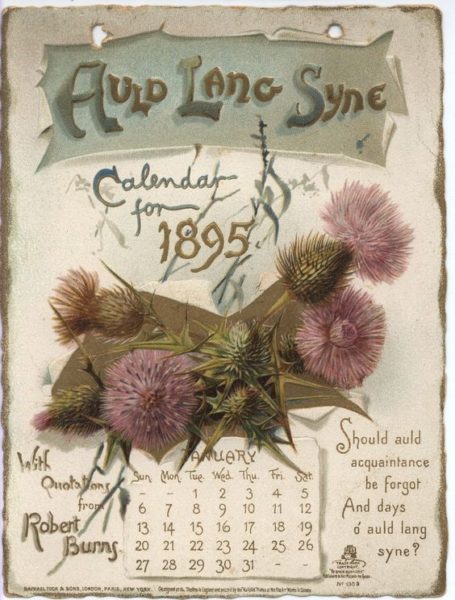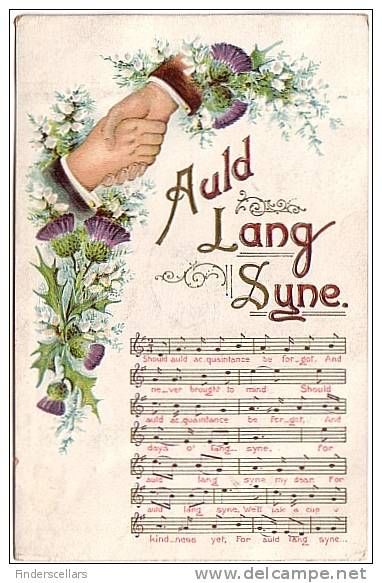 Last updated: August 10, 2023
Last updated: August 10, 2023
Every year on New Year’s Eve, most Americans (at least those of us who don’t go to sleep early) sing Auld Lang Syne just after the champagne is popped and the clock strikes midnight. But – go ahead and fess up, do you actually know all the words? Like most everyone, I didn’t, so I decided to find out and let you know too, so that you can impress your sweetie on NYE…. I also checked up on the history of this tune – since the new year is almost upon us and mostly because I was curious.
 Auld Lang Syne originated as a Scots-language poem that was popularized by Robert Burns in 1788, set to the music of a traditional folk song. The lyrics of the popular New Year’s tune are often attributed to Burns, and he claimed to have worked from ethnographic material he collected, including scraps of music that had never previously been written down. He submitted the tune to the Scots Musical Museum with a note that read, “The following song, an old song, of the olden times, and which has never been in print, nor even in manuscript until I took it down from an old man’s singing, is enough to recommend any air.”
Auld Lang Syne originated as a Scots-language poem that was popularized by Robert Burns in 1788, set to the music of a traditional folk song. The lyrics of the popular New Year’s tune are often attributed to Burns, and he claimed to have worked from ethnographic material he collected, including scraps of music that had never previously been written down. He submitted the tune to the Scots Musical Museum with a note that read, “The following song, an old song, of the olden times, and which has never been in print, nor even in manuscript until I took it down from an old man’s singing, is enough to recommend any air.”
However, in terms of lyrics, the exact phrase “auld lang syne” can also be found in similar poems by Robert Ayton (1570–1638) and Allan Ramsay (1686–1757.) And the first verse and chorus are even more closely related to a poem written by James Watson in 1711. It is thought that the remaining lyrics of the other verses were most likely written by Burns. A tradition of singing the song on Hogmanay (Scots version of NYE) became customary and spread throughout the British Isles and world-wide, as Scots and Brits emigrated around the globe.
In the United States, Auld Lang Syne became wildly famous, due to the Canadian band leader Guy Lombardo and his orchestra in the late 1920s. Lombardo was acquainted with the folk tune that was brought to Ontario by Scots immigrants, and frequently used it as a transitional song in concerts and radio programs.
 The legend is that in 1929, Auld Lang Syne was played in their live radio performance, as the programming was switching from CBS to NBC that began exactly at the stroke of midnight. Beginning that year and every year until 1976, Guy Lombardo’s orchestra played Auld Lang Syne at New Year’s Eve parties, initially at the Roosevelt Hotel in NYC and later at the Waldrof Astoria Hotel.
The legend is that in 1929, Auld Lang Syne was played in their live radio performance, as the programming was switching from CBS to NBC that began exactly at the stroke of midnight. Beginning that year and every year until 1976, Guy Lombardo’s orchestra played Auld Lang Syne at New Year’s Eve parties, initially at the Roosevelt Hotel in NYC and later at the Waldrof Astoria Hotel.
Ok. Here is the test – sing the first verse and chorus to Auld Lang Syne without looking below. I could get it all except for “cup of kindness.” And if you can’t get it all, you can still feel ok about that, since a blog post at https://www.midlifesmarts.com/celebrate-new-year-scotland-style/ says that a recent survey indicates that 97% of Scots have no idea what the words are either.
VERSE 1: Should auld acquaintance be forgot? And never brought to mind? Should auld acquaintance be forgot? And auld lang syne!
CHORUS: For auld lang syne, my dear. For auld lang syne. We’ll take a cup o’ kindness yet. For auld lang syne.
So this is about all we can usually manage to sing on New Year’s Eve, after drinking a good deal and engaging in general merriment. And if you got most of the words, that’s great, but don’t just stop there. You can get bonus points if you know any of the words to the other four verses that I believe can give us a glimpse that goes to the heart of the original meaning of the Scottish tune. So what is a “pint stowp” or “gude-willie waught anyway really?” Below are the words of the remaining verses with English translation suggestions in parenthesis for some of the more cryptic words. This definitely has the feel of a song you would sing with your buddies at some Scottish pub, which I imagine was largely the point. So lift a pint, say cheers all around and read below.
 VERSE 2: And surely ye’ll be your pint stowp! (buy your pint cup) And surely I’ll be (buy) mine! And we’ll tak a cup o’ kindness yet. For auld lang syne.
VERSE 2: And surely ye’ll be your pint stowp! (buy your pint cup) And surely I’ll be (buy) mine! And we’ll tak a cup o’ kindness yet. For auld lang syne.
VERSE 3: We twa hae (two have) run about the braes, (slopes.) And pour’d (picked) the gowans (daisies) fine; But we’ve wandered mony a weary foot. Sin’ auld lang syne.
VERSE 4: We twa hae paidl’d (two have paddled) in the burn, (stream.) Frae (from) mornin’ sun till dine; But seas between us braid hae roar’d, (broad have roared.) Sin’ auld lang syne.
 VERSE 5: And here’s a hand, my trusty fiere! (friend) And gie’s (give) a hand o’ thine! And we’ll tak a right gude-willie waught, (good-will draught.) For auld lang syne.
VERSE 5: And here’s a hand, my trusty fiere! (friend) And gie’s (give) a hand o’ thine! And we’ll tak a right gude-willie waught, (good-will draught.) For auld lang syne.
So, this year I will be celebrating New Year’s Eve with Andy and my sister Lori. And now that I know the words to Auld Lang Syne, I am ready for the festivities! Wishing all of my friends (past, present, and future) a very happy and healthy new decade, New Year 2020!
Reference 1: “How to Celebrate New Year – Scotland Style,” blog post by Jill, December 30, 2017, at https://www.midlifesmarts.com/celebrate-new-year-scotland-style/.
Reference 2: “Auld Lang Syne,” Wikipedia, https://en.m.wikipedia.org/wiki/Auld_Lang_Syne?wprov=sfti1
Reference 3: “Why We Sing Auld Lang Syne on New Year’s Eve,” blog post by Miss Celania, December 17, 2013 at https://www.neatorama.com/2013/12/17/Why-We-Sing-Auld-Lang-Syne-on-New-Years-Eve/#!p90cU
Reference 4: “The Real Reason People Sing “Auld Lang Syne” on New Year’s Eve, by Olivia Waxman, Time Magazine, December 27, 2017 at http://time.com/5061965/auld-lang-syne-new-years-eve-history/?utm_source=time.com&utm_medium=email&utm_campaign=the-brief&utm_content=2017123115pm&xid=newsletter-brief
Image 1: “New Year’s Auld Lang Syne,” Vintage New Year’s post card, blog post, January 10, 2013 at http://contancedenniger.blogspot.com.
Image 2: Portrait of Robert Burns, by Alexander Nasmyth (1758-1840,) National Galleries of Scotland, Scottish National Portrait Gallery, accession number PG 1063.
Image 3: Auld Lang Syne calendar, unknown American publisher, 1895.
Image 4: Engraving from 1841 illustrating auld lang syne poem, by John Masey Wright (1777-1866) and John Rogers (1808-1888,) wikipedia.com, public domain.
Image 5: “Auld Lang Syne,” music and card, unknown American publisher, 1908, posted at www.delcampe.net.















2 Comments
Leave your reply.